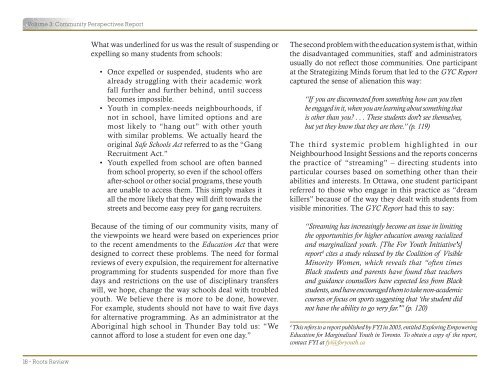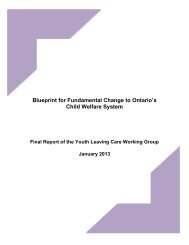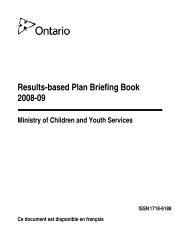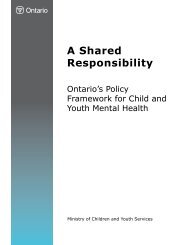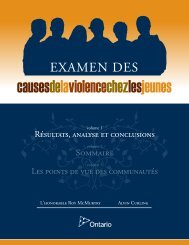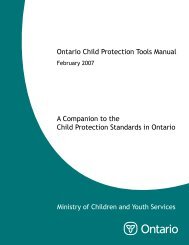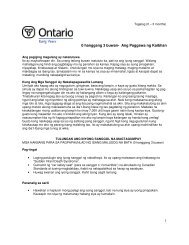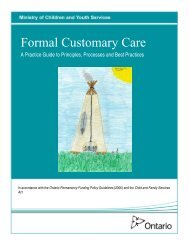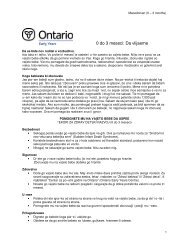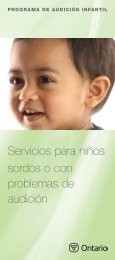Roots of Youth Violence - Ministry of Children and Youth Services
Roots of Youth Violence - Ministry of Children and Youth Services
Roots of Youth Violence - Ministry of Children and Youth Services
Create successful ePaper yourself
Turn your PDF publications into a flip-book with our unique Google optimized e-Paper software.
Volume 3: Community Perspectives Report<br />
What was underlined for us was the result <strong>of</strong> suspending or<br />
expelling so many students from schools:<br />
• Once expelled or suspended, students who are<br />
already struggling with their academic work<br />
fall further <strong>and</strong> further behind, until success<br />
becomes impossible.<br />
• <strong>Youth</strong> in complex-needs neighbourhoods, if<br />
not in school, have limited options <strong>and</strong> are<br />
most likely to “hang out” with other youth<br />
with similar problems. We actually heard the<br />
original Safe Schools Act referred to as the “Gang<br />
Recruitment Act.”<br />
• <strong>Youth</strong> expelled from school are <strong>of</strong>ten banned<br />
from school property, so even if the school <strong>of</strong>fers<br />
after-school or other social programs, these youth<br />
are unable to access them. This simply makes it<br />
all the more likely that they will drift towards the<br />
streets <strong>and</strong> become easy prey for gang recruiters.<br />
Because <strong>of</strong> the timing <strong>of</strong> our community visits, many <strong>of</strong><br />
the viewpoints we heard were based on experiences prior<br />
to the recent amendments to the Education Act that were<br />
designed to correct these problems. The need for formal<br />
reviews <strong>of</strong> every expulsion, the requirement for alternative<br />
programming for students suspended for more than five<br />
days <strong>and</strong> restrictions on the use <strong>of</strong> disciplinary transfers<br />
will, we hope, change the way schools deal with troubled<br />
youth. We believe there is more to be done, however.<br />
For example, students should not have to wait five days<br />
for alternative programming. As an administrator at the<br />
Aboriginal high school in Thunder Bay told us: “We<br />
cannot afford to lose a student for even one day.”<br />
The second problem with the education system is that, within<br />
the disadvantaged communities, staff <strong>and</strong> administrators<br />
usually do not reflect those communities. One participant<br />
at the Strategizing Minds forum that led to the GYC Report<br />
captured the sense <strong>of</strong> alienation this way:<br />
“If you are disconnected from something how can you then<br />
be engaged in it, when you are learning about something that<br />
is other than you . . . These students don’t see themselves,<br />
but yet they know that they are there.” (p. 119)<br />
The third systemic problem highlighted in our<br />
Neighbourhood Insight Sessions <strong>and</strong> the reports concerns<br />
the practice <strong>of</strong> “streaming” – directing students into<br />
particular courses based on something other than their<br />
abilities <strong>and</strong> interests. In Ottawa, one student participant<br />
referred to those who engage in this practice as “dream<br />
killers” because <strong>of</strong> the way they dealt with students from<br />
visible minorities. The GYC Report had this to say:<br />
“Streaming has increasingly become an issue in limiting<br />
the opportunities for higher education among racialized<br />
<strong>and</strong> marginalized youth. [The For <strong>Youth</strong> Initiative’s]<br />
report 4 cites a study released by the Coalition <strong>of</strong> Visible<br />
Minority Women, which reveals that “<strong>of</strong>ten times<br />
Black students <strong>and</strong> parents have found that teachers<br />
<strong>and</strong> guidance counsellors have expected less from Black<br />
students,<strong>and</strong>haveencouragedthemtotakenon-academic<br />
courses or focus on sports suggesting that ‘the student did<br />
not have the ability to go very far.’” (p. 120)<br />
4<br />
This refers to a report published by FYI in 2003, entitled Exploring Empowering<br />
Education for Marginalized <strong>Youth</strong> in Toronto. To obtain a copy <strong>of</strong> the report,<br />
contact FYI at fyi@foryouth.ca<br />
16 • <strong>Roots</strong> Review


